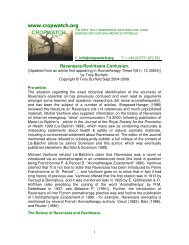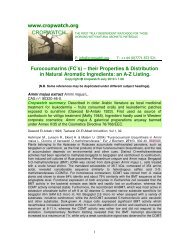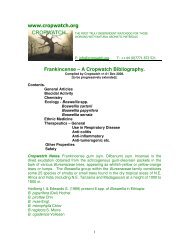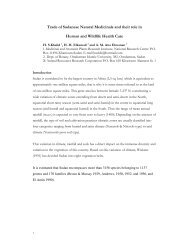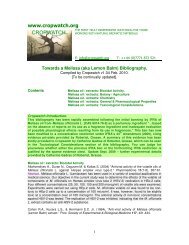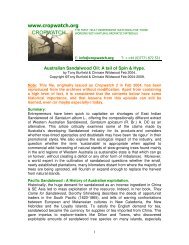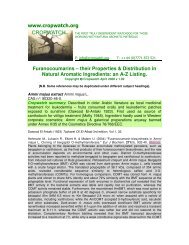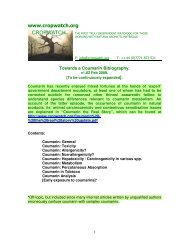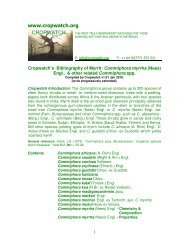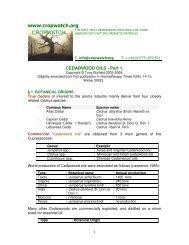Sandalwood Biblio - Cropwatch
Sandalwood Biblio - Cropwatch
Sandalwood Biblio - Cropwatch
Create successful ePaper yourself
Turn your PDF publications into a flip-book with our unique Google optimized e-Paper software.
Samson, Basil (1980): The camp at Wallaby Cross. Canberra: Australian Institute of Aboriginal<br />
Studies; 199-202.<br />
Sawyer (1892) through Applegate Graham B, Davis Allan G.W. & Annable. Peter A. (1990)<br />
“Managing <strong>Sandalwood</strong> for Conservation in N. Queensland, Australia” in Proc of the Symposium<br />
on <strong>Sandalwood</strong> in the Pacific: April 9-11, 1990, Honolulu, Hawai/technical co-ordinators:<br />
Lawrence Hamilton, C. Eugene Conrad. pub: Symposium on <strong>Sandalwood</strong> Conservation (1st:<br />
1991: Honolulu, Hawaii).<br />
Sedgley M. (1982). “Preliminary assessment of an orchard of quandong seedling trees.” J. Aust.<br />
Inst. Agr. Sci. 48(l):52-56.<br />
Sedgley M (1982) "Floral anatomy andpollen-tube growth in the Quan-dong (Santalum<br />
acuminatum (R Br) a Dc)." Australian Journal of Botany 30, 601-609..Abstract. Floral anatomy<br />
and pollen tube growth in the quandong were studied using light and scanning electron<br />
microscopy. The flowers had four perianth lobes and four stamens whose anthers dehisced by<br />
longitudinal slits. The pollen became caught in long unicellular hairs adjacent to the anthers. The<br />
central disc secreted nectar through raised stomata. The stigma papilla cells had a cuticle with a<br />
rough surface overlying thick PAS-positive walls. The half-inferior ovary normally contained two<br />
ovules. The embryo sac extended beyond the ovule at the micropylar end and into the placenta at<br />
the chalazal end. Half of the ovaries observed at both anthesis and 4 days following anthesis had<br />
no embryo sacs and the other half had one embryo sac. Occasional ovaries had two embryo sacs<br />
and some underdeveloped embryo sacs were observed that did not extend beyond the ovule or<br />
into the placenta. Pollen tubes had reached the ovary by 1 day following pollination and the<br />
stigma was receptive for 8 days following anthesis. Only half of the pistils had pollen tubes in the<br />
ovary. Unpollinated flowers had no pollen tube growth in the pistil.<br />
Sen-Sarma P.K. (1982) “Insect vectors of sandal spike disease” European J of Forest Pathology<br />
12(4/5), 297-299.<br />
Shea S.R., Radmomiljac A.M., Brand & Jones P. (1998) “An overview of sandalwood and the<br />
development of sandal in Farm Forestry in W. Australia”. ACIAR Proceedings 84, 9-18.<br />
Sidheswaran P. & Ganguli S. (1997) “<strong>Sandalwood</strong> oil substitutes – a review” Supplement to<br />
Cultivation & Utilisation of Aromatic Plants 123-139.<br />
Statham P. (1988). “The Australian sandalwood trade, small but significant.” Working Paper No.<br />
100. Canberra, Australia. Department of Economic History, The Australian National University. 36<br />
Statham P. (1990) “The sandalwood Industry in Australia: A history” in Proc of the Symposium on<br />
<strong>Sandalwood</strong> in the Pacific: April 9-11, 1990, Honolulu, Hawai/technical co-ordinators: Lawrence<br />
Hamilton, C. Eugene Conrad. Pub: Symposium on <strong>Sandalwood</strong> Conservation (1st: 1991:<br />
Honolulu, Hawaii). p26. Abstract. From its inception in 1805, when it contributed to Sydney<br />
merchant incomes from whaling ventures, until today, when it earns several million dollars in<br />
export revenue, the sandalwood industry has played a small but significant part in Australia's<br />
economic development. The history of the industry falls into three major stages: first is the offshore<br />
exploitation of the wood from Sydney, from 1805 to the 1840's and beyond; second is the<br />
free exploitation of Australian grown sandalwood from 1844 to 1929; and finally the period of<br />
government controlled exploitation from 1929 to the present.<br />
Struthers R., Lamont B.B., Fox J.E.D., Wijesuriya S. & Crossland T. “Mineral nutrition of<br />
sandalwood (Santalum spicatum).” J. of Exptl. Botany 37(182), 1274-1284.<br />
Surate I.K. (1994) “The effect of hostplants on the growth of sandalwood seedlings (Santalum<br />
album Linn).” In: <strong>Sandalwood</strong> Research Newsletter Issue 3. Department of Conservationand<br />
Land Management, Kununurra, Western Australia.<br />
18





